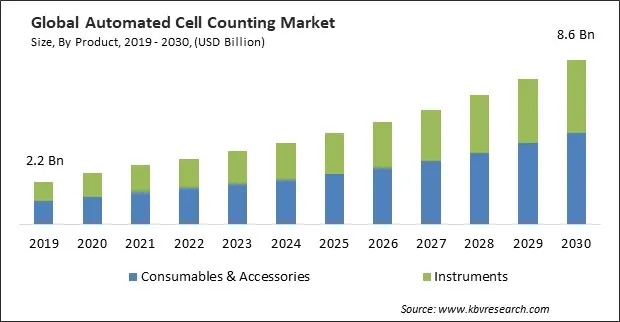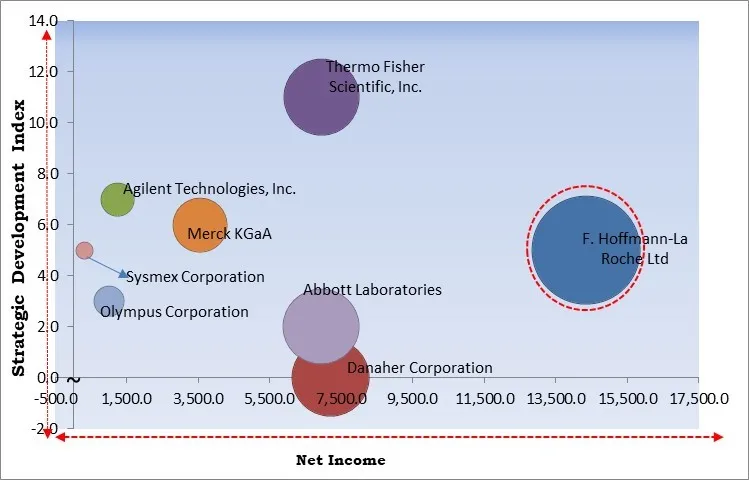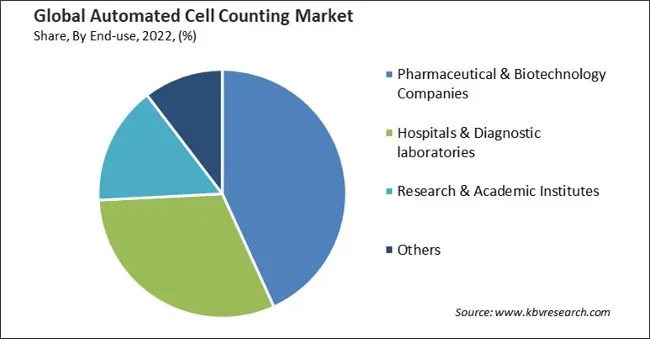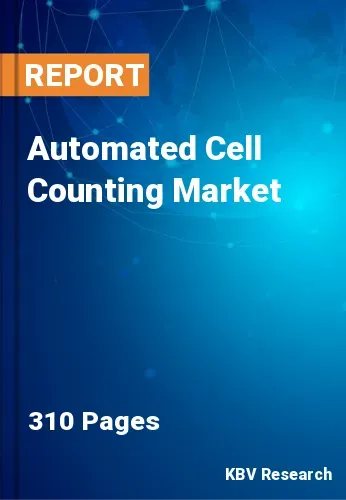The Global Automated Cell Counting Market size is expected to reach $8.6 billion by 2030, rising at a market growth of 12.2% CAGR during the forecast period.
Image-based cell counters offer high accuracy and precision in cell counting and analysis. Therefore, the Image-based Cell Counters segment captured $424.4 million revenue in the market in 2022. These systems use advanced imaging technology and algorithms to capture and analyze cell images, providing detailed information about cell morphology, viability, and concentration. As research methodologies become more advanced and diverse, the demand for accurate and efficient cell counting solutions, particularly those based on imaging technology, is expected to grow.

The major strategies followed by the market participants are Product Launches as the key developmental strategy to keep pace with the changing demands of end users. For instance, In September, 2022, Thermo Fisher Scientific, Inc. released the DynaSpin Single-Use Centrifuge system. The system is specifically meant for large-scale cell culture harvesting and aids the users in reducing overall production. Additionally, In October, 2021, Sysmex Corporation unveiled XN-30 Automated Haematology Analyzer for malaria detection. The XN-30 leverages a combination of specialized reagents, advanced algorithms, and violet laser to differentiate P. falciparum from non-falciparum species and find out the life cycle staging of the parasites detected.
Based on the Analysis presented in the KBV Cardinal matrix; F. Hoffmann-La Roche Ltd. are the forerunners in the market. In December, 2021, F. Hoffmann-La Roche Ltd announced the launch of three new automated digital pathology algorithms, uPath Ki-67 (30-9), uPath PR (1E2), and uPath ER (SP1) image analysis for breast cancer. The algorithms facilitate the whole slide analysis workflow with automated pre-computing of the slide image before pathologist assessment which aids the pathologists in quantification of the breast cancer markers. Companies such as Thermo Fisher Scientific, Inc., Abbott Laboratories and Danaher Corporation are some of the key innovators in the market.

During the pandemic, research efforts and resources were significantly redirected toward understanding the SARS-CoV-2 virus, developing diagnostic tests, and developing vaccines. This temporary shift in research priorities led to a slowdown in some regions of non-COVID-related research, including automated cell counting applications in other fields. The pandemic disrupted global supply chains, affecting the production, distribution, and availability of mechanical cell counting instruments and related consumables. Delays in manufacturing, shipping constraints, and logistical challenges temporarily impacted the market's growth. Therefore, the COVID-19 pandemic moderately impacted the market.
Increasing government funding for cell-based research is crucial in advancing scientific discoveries, technological innovations, and therapeutic developments in cell biology, regenerative medicine, and related areas. Increased funding allows scientists to delve deeper into understanding cellular mechanisms, signalling pathways, and the behaviour of various cell types. This fundamental knowledge forms the basis for developing targeted therapies and interventions for chronic diseases. Funding aids in exploring the potential of stem cells in regenerative medicine, tissue engineering, and disease modelling, paving the way for novel treatments and organ regeneration. Thus, the increasing government funding in research and development is driving the growth of the market.
The growing domain of cellular agriculture, which encompasses the production of cell-based livestock, dairy, eggs, and other products, presents novel applications for automated cell counting instruments. Cell proliferation and culture constitute an integral component of the manufacturing process that necessitates meticulous oversight. Value can be captured in this niche by firms that develop good manufacturing practice (GMP) compliant automated counter solutions for food biomanufacturing facilities. Investments and partnerships with cellular agriculture firms may present opportunities for long-term expansion. Thus, the increasing trend of cell-based food is propelling the growth of the market.
Proficient staff and technical knowledge are necessary to operate and maintain sophisticated automated cell counters effectively, particularly those that rely on images. Numerous laboratories hindered by budgetary and resource constraints must provide specialized training. The insufficiency of competent personnel capable of harnessing the complete potential of the systems constitutes a constraining element. Insufficient capacity in healthcare education programs, such as nursing schools and medical colleges, limits the number of qualified professionals entering the field. Hence, a scarcity of trained and skilful personnel is impeding the growth of the market.
On the basis of application, the market is segmented into blood analysis, stem cell research, cell line development, and others. In 2022, the blood analysis segment attained a noteworthy revenue share in the market. Blood analysis is a fundamental aspect of clinical diagnostics. The increasing demand for blood analysis is driven by the need for accurate and timely diagnosis, technological advancements, a focus on personalized medicine, and the crucial role of blood testing in various healthcare settings, making it a cornerstone in disease management, treatment, and research.
Based on the end-use, the market is categorized into pharmaceutical biotechnology companies, hospitals diagnostic laboratories, research academic institutes, and others. The pharmaceutical biotechnology companies segment witnessed the highest revenue share in the market in 2022. Several pharmaceutical and biotechnological companies play significant roles in the market, either as manufacturers of automated cell counting instruments or as users leveraging this technology for their research, drug development, and manufacturing processes.

Based on product, the market is bifurcated into instruments and consumables accessories. The consumables and accessories segment garnered the highest revenue share in the market in 2022. As the adoption of automated cell counting instruments like flow cytometers, image-based cell counters, and haematology analysers rises, so does the need for consumables and accessories associated with these instruments. The increasing demand for consumables and accessories in the market is closely linked to the expanding applications of cell analysis technologies and the need for standardization and quality control.
The instruments segment is subdivided into flow cytometers, image-based cell counters, and electrical impedance coulter counters. In 2022, the flow cytometers segment procured a noteworthy revenue share in the market. These instruments provide high throughput and multiparametric analysis of cells, enabling researchers, clinicians, and pharmaceutical companies to gain deeper insights into cellular functions, disease mechanisms, and therapeutic developments. Technological advancements, expanding applications, and the increasing need for precise and comprehensive cell analysis contribute to the rising demand for flow cytometers.
| Report Attribute | Details |
|---|---|
| Market size value in 2022 | USD 3.4 Billion |
| Market size forecast in 2030 | USD 8.6 Billion |
| Base Year | 2022 |
| Historical Period | 2019 to 2021 |
| Forecast Period | 2023 to 2030 |
| Revenue Growth Rate | CAGR of 12.2% from 2023 to 2030 |
| Number of Pages | 310 |
| Number of Table | 454 |
| Report coverage | Market Trends, Revenue Estimation and Forecast, Segmentation Analysis, Regional and Country Breakdown, Competitive Landscape, Porter’s 5 Forces Analysis, Company Profiling, Companies Strategic Developments, SWOT Analysis, Winning Imperatives |
| Segments covered | Product, End-use, Application, Region |
| Country scope |
|
| Companies Included | Shanghai Ruiyu Biotechnology Co., Ltd. (Alit Biotech (Shanghai) Co., Ltd.), Thermo Fisher Scientific, Inc., Bio-Rad laboratories, Inc., F. Hoffmann-La Roche Ltd., Danaher Corporation, Olympus Corporation, Merck KGaA, Abbott Laboratories, Sysmex Corporation, and Agilent Technologies, Inc. |
| Growth Drivers |
|
| Restraints |
|
Region-wise, the market is analysed across North America, Europe, Asia Pacific, and LAMEA. The North America region witnessed the maximum revenue share in the market in 2022. North America holds a significant position in the market. Regions like Silicon Valley and clusters in Boston and San Francisco are home to numerous biotech firms and research institutions driving technological advancements in automated cell counting. Robust government funding for research and development in life sciences, biotechnology, and healthcare supports advancements in cell counting technology.
Free Valuable Insights: The Global Automated Cell Counting Market size to reach USD 8.6 Billion by 2030
The market research report covers the analysis of key stake holders of the market. Key companies profiled in the report include Shanghai Ruiyu Biotechnology Co., Ltd. (Alit Biotech (Shanghai) Co., Ltd.), Thermo Fisher Scientific, Inc., Bio-Rad laboratories, Inc., F. Hoffmann-La Roche Ltd., Danaher Corporation, Olympus Corporation, Merck KGaA, Abbott Laboratories, Sysmex Corporation, and Agilent Technologies, Inc.
By Product
By Application
By End-use
By Geography


This Market size is expected to reach $8.6 billion by 2030.
Growing government expenditure for R D are driving the Market in coming years, however, Requirement for specialized operators and training restraints the growth of the Market.
Shanghai Ruiyu Biotechnology Co., Ltd. (Alit Biotech (Shanghai) Co., Ltd.), Thermo Fisher Scientific, Inc., Bio-Rad laboratories, Inc., F. Hoffmann-La Roche Ltd., Danaher Corporation, Olympus Corporation, Merck KGaA, Abbott Laboratories, Sysmex Corporation, and Agilent Technologies, Inc.
The expected CAGR of this Market is 12.2% from 2023 to 2030.
The Cell Line development segment is generating highest revenue in the Market by Application in 2022; thereby, achieving a market value of $3.1 billion by 2030.
The North America region dominated the Market by Region in 2022 and would continue to be a dominant market till 2030; thereby, achieving a market value of $3.1 billion by 2030.
Our team of dedicated experts can provide you with attractive expansion opportunities for your business.

